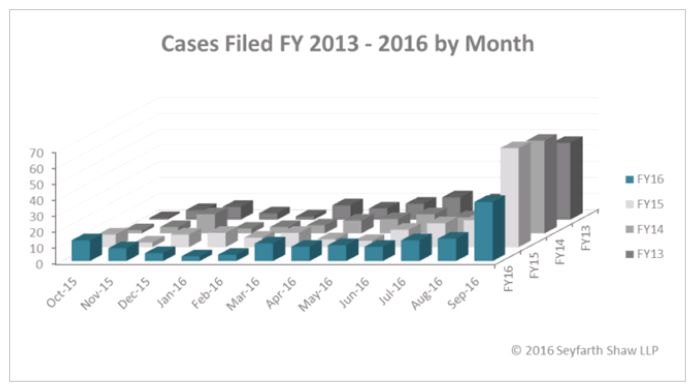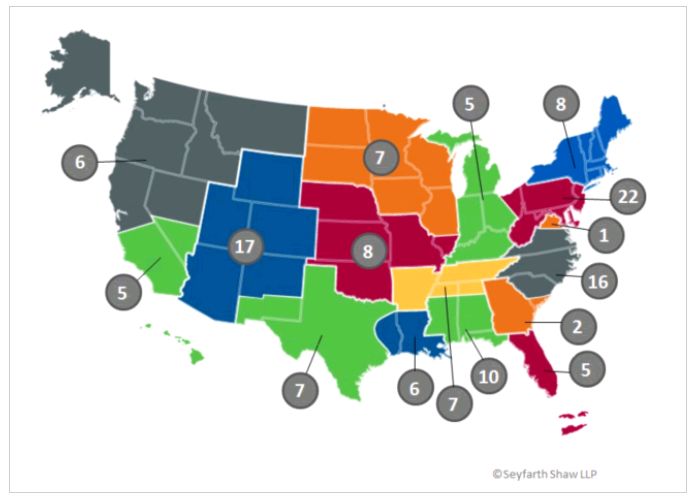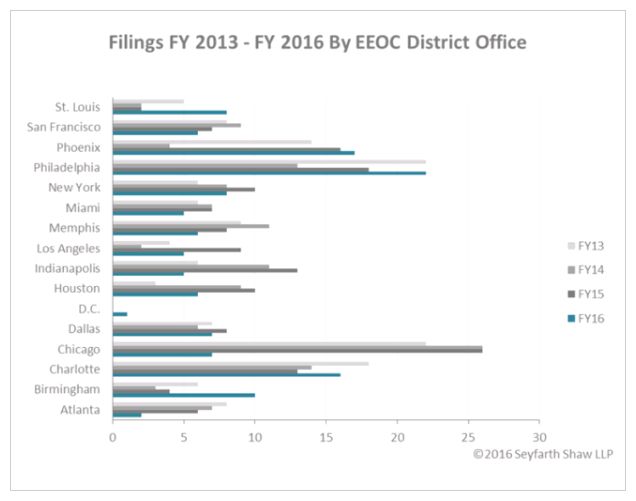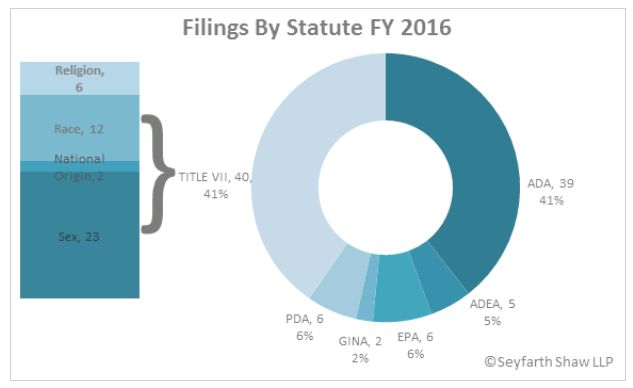Seyfarth Synopsis: With the end of another EEOC fiscal year employers look with anticipation to what the year-end trends can tell us about the sometimes elusive EEOC litigation agenda. In years past, the EEOC has engaged in a "filing frenzy," with dozens of lawsuits filed in the waning days of the fiscal year. Although there was an uptick in filings this year, the EEOC's FY 2016 went out with a whimper and not a roar.
We have prepared the following chart, which shows the total monthly filings for FY 2013-2016, which highlights the EEOC's historical year-end filings compared to the somewhat tepid activity that we saw this year.

As with prior years, we anticipate that the EEOC may continue to file cases well into the night in the courthouses of the Western states, so the final tally may not be known for another 48 hours. But at the time of publication, the raw numbers show that the EEOC filed 136 lawsuits in FY 2016 (99 merits lawsuits and 37 subpoena enforcement actions). This is significantly less than prior years. (See here, here, here, and here.) The reason for this significant drop in lawsuits most likely can be attributed to the EEOC's limited budget coupled to an already bloated litigation inventory. The fact that this is an election year with all of the possible changes that may represent could also be impacting the EEOC's willingness to commit to additional litigation so close to November.
FY 2016 was originally planned to be the final year of the EEOC's 2013-2016 Strategic Enforcement Plan ("SEP"). The EEOC developed the SEP in 2012 in order to set its priorities and goals for enforcement activity through 2016. Last year, the EEOC received permission from the Office of Management and Budget to delay the release of a new SEP until 2018 so that the Commission could align its strategic planning with other agencies. Although the SEP has now been extended through 2018, this year still marks the final planned year, and provides a useful moment in time to look back and take stock of where the agency has driven its enforcement program over the past four years.
Cases Filed By EEOC District Offices
Location is always a key factor for defending against EEOC litigation. Year after year, certain EEOC district offices distinguish themselves by the number of cases that they file. The map below shows the number of filings by each district office in FY 2016.

Filings by district office in FY 2016 were pretty much on par with prior years with one glaring exception. Year over year, Chicago has been the consistent leader in terms of total cases filed. Last year alone, the Chicago office filed 27 lawsuits. This year, the Chicago office filed only 7, a shockingly low number for that office. The other traditional filing leaders stayed consistent with prior years, and some even ticked up a bit in FY 2016. The Philadelphia office filed 22 lawsuits in FY 2016, up from 19 last year. The Charlotte office filed 16 lawsuits this year, compared with 13 last year. The Phoenix office filed 17 lawsuits in FY 2016, the same as last year. The bar chart below compares the number of filings from each office for FY 2013 – FY 2016.

What Do The FY 2016 Filings Say About The EEOC's Priorities?
Each fiscal year we analyze the EEOC's filings to determine substantive trends. The following chart shows the number of claims categorized by statute, along with a further division of the largest category – Title VII – by discrimination theory.
As with prior years, Title VII cases were the majority of cases filed, making up 41% of all filings (as compared with 55% in FY 2015 and 57% in FY 2014). This is not particularly surprising given the number of protected groups covered by the statute. ADA cases also made up a significant percentage of the EEOC's filings, totaling 41% this year. Together, complaints alleging discrimination under those two statues made up 82% of all cases filed in FY 2016. Age cases represented a relatively small 5% of the overall cases.

In late August, the EEOC issued its final revision to the Enforcement Guidance on Retaliation and Related Issues (which we discuss here), replacing the 18 year old Section 8, "Retaliation" portion of the Compliance Manual last updated in 1998. This revision touches upon all of the statutes which the Commission enforces, and covers the legal analysis used to define evidence that supports retaliation claims as well as retaliation remedies, legal access for persons with disabilities under the ADA, and even a play-by-play of employer/employee interactions that might prompt retaliation.
Considering the EEOC's renewed focus on this area, we analyzed the FY 2016 retaliation cases to test which discrimination claims are most often paired with a retaliation claim. The following chart shows which types of discrimination were paired with retaliation allegations in FY 2016:

Sex + retaliation cases make up the largest percentage of these claims at 46%, followed by race discrimination at 27%, pay discrimination at 13%, age discrimination at 7%, and disability discrimination at 7%. Pregnancy discrimination, national origin discrimination, religious discrimination, and genetic discrimination all had zero claims of retaliation.
In addition to the revised retaliation guidelines, the EEOC also revised its Employer Information Report (EEO-1) yesterday to require employers to submit information regarding employee pay range and hours worked. The Commission asserts that the purpose of collecting this pay data along with race, ethnicity, sex, and job category would be to "assess complaints of discrimination, focus agency investigations, and identify existing pay disparities that may warrant further examination." It is, by most accounts, an ominous development for the future of EEOC litigation.
The EEOC also issued its final rules on employer wellness programs as they relate to the ADA and GINA, which clarify the implications of those rules and their interactions with employer wellness programs. We reported on this development here. Harassment was also a hot button issue for the Commission in FY 2016, with a particular focus on Muslims and people of Middle Eastern origin. Among other things, the EEOC issued a call-to-action for employers to 'reboot' harassment prevention efforts (which we discuss here).
Insight & Implications For Employers: Conclusions
As with prior years, this year's analysis reveals that the EEOC's activities continue to be guided by the 2012 SEP. For the past four years, we have reported on the many ways that the SEP has guided and shaped the EEOC's enforcement initiatives – and with that, the landscape of labor and employment law. FY 2016 was the last year that was planned to be covered by the 2012 SEP. As we enter FY 2017, it is unclear whether we will see more of the same, or if we will see the EEOC branching out to new priorities and initiatives that may line up with its vision for the 2018 SEP and the future of EEOC litigation.
We will continue to analyze the data and filings from FY 2016 to extract additional insight about the EEOC's litigation priorities, and what employers should watch out for in FY 2017 and beyond. We look forward to distilling those observations into our annual analysis of trends and developments affecting EEOC litigation. We hope that you are looking forward to that publication as much as we are, and that you continue to find it a useful reference and guide to developments in EEOC litigation. Please stay tuned, loyal blog readers!
Readers can also find this post on our EEOC Countdown blog here.
The content of this article is intended to provide a general guide to the subject matter. Specialist advice should be sought about your specific circumstances.



